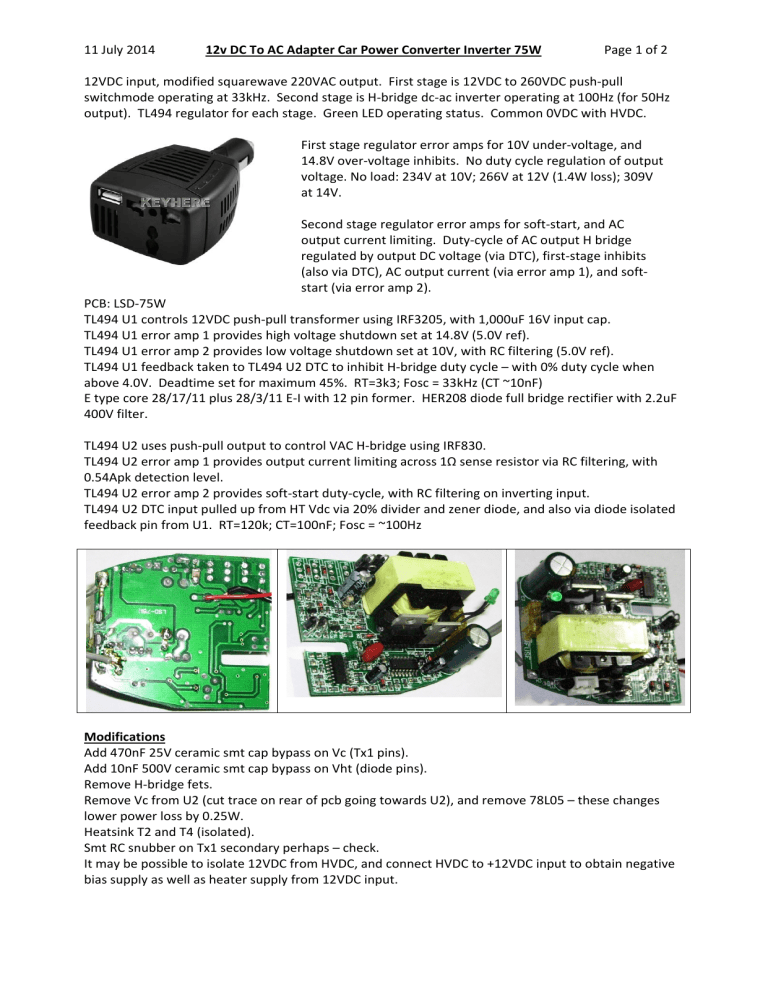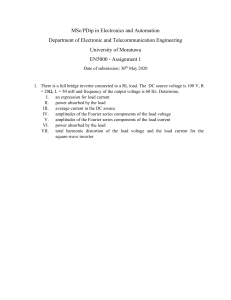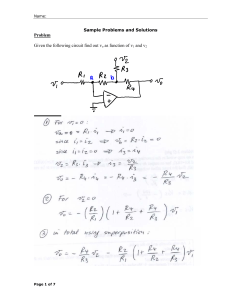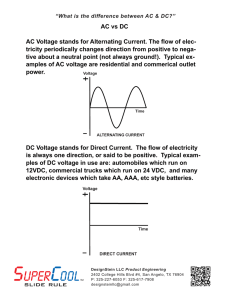
11 July 2014 12v DC To AC Adapter Car Power Converter Inverter 75W Page 1 of 2 12VDC input, modified squarewave 220VAC output. First stage is 12VDC to 260VDC push‐pull switchmode operating at 33kHz. Second stage is H‐bridge dc‐ac inverter operating at 100Hz (for 50Hz output). TL494 regulator for each stage. Green LED operating status. Common 0VDC with HVDC. First stage regulator error amps for 10V under‐voltage, and 14.8V over‐voltage inhibits. No duty cycle regulation of output voltage. No load: 234V at 10V; 266V at 12V (1.4W loss); 309V at 14V. Second stage regulator error amps for soft‐start, and AC output current limiting. Duty‐cycle of AC output H bridge regulated by output DC voltage (via DTC), first‐stage inhibits (also via DTC), AC output current (via error amp 1), and soft‐ start (via error amp 2). PCB: LSD‐75W TL494 U1 controls 12VDC push‐pull transformer using IRF3205, with 1,000uF 16V input cap. TL494 U1 error amp 1 provides high voltage shutdown set at 14.8V (5.0V ref). TL494 U1 error amp 2 provides low voltage shutdown set at 10V, with RC filtering (5.0V ref). TL494 U1 feedback taken to TL494 U2 DTC to inhibit H‐bridge duty cycle – with 0% duty cycle when above 4.0V. Deadtime set for maximum 45%. RT=3k3; Fosc = 33kHz (CT ~10nF) E type core 28/17/11 plus 28/3/11 E‐I with 12 pin former. HER208 diode full bridge rectifier with 2.2uF 400V filter. TL494 U2 uses push‐pull output to control VAC H‐bridge using IRF830. TL494 U2 error amp 1 provides output current limiting across 1Ω sense resistor via RC filtering, with 0.54Apk detection level. TL494 U2 error amp 2 provides soft‐start duty‐cycle, with RC filtering on inverting input. TL494 U2 DTC input pulled up from HT Vdc via 20% divider and zener diode, and also via diode isolated feedback pin from U1. RT=120k; CT=100nF; Fosc = ~100Hz Modifications Add 470nF 25V ceramic smt cap bypass on Vc (Tx1 pins). Add 10nF 500V ceramic smt cap bypass on Vht (diode pins). Remove H‐bridge fets. Remove Vc from U2 (cut trace on rear of pcb going towards U2), and remove 78L05 – these changes lower power loss by 0.25W. Heatsink T2 and T4 (isolated). Smt RC snubber on Tx1 secondary perhaps – check. It may be possible to isolate 12VDC from HVDC, and connect HVDC to +12VDC input to obtain negative bias supply as well as heater supply from 12VDC input. 11 July 2014 12v DC To AC Adapter Car Power Converter Inverter 75W Page 2 of 2 Marketing info: •Max. output power: 100W, continuous output power: 75W •With the multiple protection circuit, it would do no harm to the equipment and automobile •Please pull out this product from the cigar socket when you do not use this product •Input voltage range DC 11V‐15V •Output voltage range AC 220V, not use for AC 110V •Max, output power 100W •Continuous output power 75W •Over voltage shutdown DC 15V‐16V •Low voltage shutdown DC 10V‐10.5V •USB output DC 5V http://dalmura.com.au/projects/75W car inverter.pdf Another similar 75W inverter Changes noticed were: no dc fuse; heatsinking of push‐pull fets; high voltage shutdown level of 18.5V; core size 28/20/10; UF4007 bridge diodes; 3.3uF 400V cap; IRFS730 bridge fets; MC34063 buck conversion stage for 5V USB; AC terminals on pcb; USB connector on pcb. It appears the pcb could be cut along the AC output terminal rectangular pad lines to make a significantly smaller pcb size. Measured: 12V for 236V no load; 14V for 274V no load; low voltage ~11V on, and 10V off; high voltage ~14.5V off. (. ~ . I~ If' I .I : c .. '<'l . of i", \;! I~ ~ ~ \ "V V} r' .. Q~ ~ <~ .r.O:: ~ ''': ,f; :9~ -;~ ~ 'J -:f 'i\ ~ ~. V Vj ~. Ft ~ ''(





